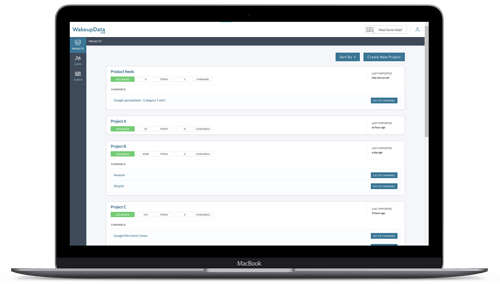How to improve your product feed on Pinterest?
Posted on May 22, 2024 (Last Updated: May 27, 2024)
Are you selling products on Pinterest? Then you’ll want to pay attention. We're providing top-notch tips to optimize your product feed and reach a wider audience. An optimized feed leads to better performance, which means more customers finding your brand and shopping from your store.
If you're using Pinterest to drive sales, you probably already have your product feed uploaded. But when did you last update it?
Our new Image transformation tools have just launched and to honour that update, we decided to focus on the most visual social media of them all - PINTEREST. If you want to take a look at what designs you can create using personalised templates, simply book a free consultation and we will do the rest.
Your product feed—also known as a data feed, data source, or product catalogue—is crucial for lower funnel tools like product Pins and shopping ads. The information in your feed helps Pinterest’s system recommend your content and determine which users see your Pins. It also influences how your brand appears on the platform, including product descriptions and images.
To maximize the power of your data, we recommend periodically refining your feed to keep it in top shape. After analyzing hundreds of Pinterest campaigns, we’ve identified key tips for optimizing product feeds. These tips cover three main areas: metadata, product organization, and targeting.
Let’s dive in.
Psss. do you also advertise on Facebook? We have a free ebook on the content of successful advertising on Meta focused on the Scandinavian market. Want to take a look?
Enhance Your Metadata
The metadata in your product feed contains essential details about the items you want to promote. This includes Pin fields like title, description, price, and category. Pinterest uses this metadata to direct your product Pins to the users who are most likely to be interested.
Provide Comprehensive Details
Since Pinterest's system uses these fields for recommendations and targeting, it's important to make them as detailed as possible. This means providing clear, specific information about each product you’re selling on Pinterest.
For instance, if you're selling a desk lamp, your metadata should include detailed information in the title, description, and price fields. Consider the features your audience might care about. For example, is the lamp plug-in or battery-operated? Is it yellow or black? The more details you provide, the better Pinterest can target your product Pins to potential buyers.
On Pinterest, there are only seven required fields for product listings:
- id
- title
- description
- link
- image_link
- price
- Availability
Some optional attributes include:
- additional_image_link
- description_html
- product_type
- sale_price
- brand
- age_group
- colour
- gender
- material
- pattern
- size
- variant_names
- Shipping
Incorporate Keywords in Titles and Descriptions
Consider how people search for products similar to yours, and make sure to include relevant keywords in your text fields. This will enhance your visibility to both users searching for specific items and those browsing through your product category. It's a win-win.
Using a combination of broad and specific keywords and phrases can help you appear in more search queries. For instance, the title and description of this featured Pin contain multiple keywords that our system can utilize to target individuals searching for fans or related products. Combining broad terms like 'bedroom' and 'living room' with specific ones like 'tropical ceiling fan' can help your ads or Pins show up in more searches and user feeds.
- You can use up to 100 characters in your titles, so make sure to maximise your SEO worth using relevant keywords.
- Include appropriate language about the product.
- Use professional, grammatically acceptable wording.
- Avoid using foreign or gimmicky characters.
- Do not include advertising text such as the discount price, delivery dates, or sales dates.
- Put the most important product data first. Remember, Pinners can only see the first 40-70 characters before clicking on the image.
- Incorporate keywords like the product name and specific features, such as "maternity," "plus-size," or "waterproof" in clothes.

Optimize Your Product Groupings
Product groupings work behind the scenes to influence product delivery on Pinterest. While these groupings aren’t visible to shoppers, they play a crucial role in determining which products our system displays and where they appear. Properly tagging your products into multiple categorization levels will improve your visibility in relevant searches and shopping categories. Missing a category could mean missing out on a potential customer.
Use Detailed Product Classification
Ensure your product categories are as detailed as possible. For instance, if you sell headphones, don’t just use ‘Electronics’ as the sole category in your product feed. Implement a full taxonomy with broader categories and subcategories to give our systems more opportunities to display your product. Products with multiple classification levels can also enhance the likelihood of a purchase.
For example, the categorization for a handbag might look like this: Men’s Fashion > Accessories > Bags > Handbags.%20copy.png?width=747&height=420&name=Article%20Banners%20(12)%20copy.png)
Harness the Power of Product Catalogs
Uploading a product catalogue to Pinterest significantly amplifies product visibility and sales performance. Merchants who utilize Pinterest catalogues witness increased impressions and sales performance, resulting in higher returns on ad spend. Product catalogues enable merchants to publish product Pins containing essential information like price and availability, driving conversions across Pinterest’s shopping surfaces.
Facilitate Product Discovery for Shoppers
Product groups serve as curated collections of related items sharing similar attributes like style, price range, or intended usage. Think of them as departments or aisles in a physical store. For instance, a furniture retailer might have product groups for high-end wooden furniture or farmhouse-style decor. Just as you wouldn’t want customers wandering through a disorganized store, ensure your product feed is well-organized on Pinterest.
Consider Segmentation Carefully
When running shopping ads, focus on promoting specific product groups. This allows shoppers to explore a broader range of your offerings. While it might be tempting to include products in numerous groups, limit each item to one category. This not only enhances the shopping experience but also streamlines campaign measurement on your end.
Steer Clear of Targeting Constraints
Your feed’s metadata serves as just one of the many signals Pinterest utilizes to drive recommendations and targeting. It’s wise to allow the platform’s tools and algorithms to operate without additional restrictions.
When launching shopping campaigns, refrain from imposing your own targeting constraints. While it may seem counterintuitive initially, imposing restrictions can potentially curtail your reach and diminish the efficacy of our other suggestions. Have faith in your feed and the process. Let Pinterest's capabilities and your metadata handle the heavy lifting!
Think in Themes
Successful brands understand the unique features of social media platforms and leverage them to connect with their audience more effectively. On Pinterest, users seek inspiration, curating ideas reminiscent of squirrels gathering acorns. However, as a brand, your focus is on selling products rather than ideas.
For example, when listing clothing items, consider the variations in products and how they alter their representation and association. Pinterest users often navigate thematically, so aligning your products with relevant themes is key to resonating with your target audience.
.png?width=1920&height=1080&name=Article%20Banners%20(13).png)
Prioritize High-Quality Visuals
Visuals are the cornerstone of the Pinterest experience, often overshadowing text. Pinterest recommends that the best-performing visual content incorporates solid lighting, great framing, high-resolution assets, and clean text overlays. Considering that most users access Pinterest via mobile devices, opting for a vertical aspect ratio whenever possible is advisable.
Optimizing your product feed on Pinterest is key to enhancing your visibility and attracting potential customers. By fine-tuning your metadata, incorporating meaningful keywords, perfecting product groupings, and facilitating easy product discovery, you can maximize your impact on the platform.
Remember, success on Pinterest requires a balance of strategic optimization and trust in the platform's algorithms. By following these tips and allowing Pinterest's tools to work their magic, you can unlock the full potential of your products and reach a broader audience of shoppers.
Ready to elevate your Pinterest game? Implement these strategies, trust the process, and watch your sales skyrocket!
That's why WakeupData doesn't just optimize and export your data but offers add-ons like weather data, image transformation, split testing and competitor monitoring.
Find out more about Google Shopping or check out our resources below, which gives you access to downloadable ebooks, webinar content and client stories.
Stay efficient!
P.S. We are geeky and nerdy and thus love to share knowledge with our audience so do not hesitate to contact us for more information on anything feed-related through our social media channels or contact information.
Book a short meeting with us and let's talk business.


.png?width=739&height=416&name=PINTEREST%20(1).png)
-2.png?width=796&height=448&name=Article%20Banners%20(12)-2.png)




